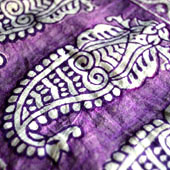Design Resource
Block Prints of Bagh
The Art of Textile Printing
by
Ferrous sulphate (used for making black dye) or alum (used for preparing red dye) is first mixed with water. After that 'imli ka chiya' (tamarind seed powder which is now a substitute for glue) is mixed into the alum or iron sulphate solution. A paste right for the consistency of printing is made. Other shades can be created by varying the ratio of different ingredients used. It takes 2-3 hours to prepare these colors. Usually large quantities are prepared at once. A drum of color lasts about four to five days.Color containing trays are covered with a bamboo frame. On top of this a felt piece is kept to avoid excessive sticking of color. Through this the color is picked up in appropriate amount by the portion of the block that is to be printed. Paper is used, whenever required, so that the unnecessary part falls on the paper and not the fabric. This is usually done at the borders of the fabric.
The fabric to be printed upon is spread over the table that has several layers of jute, blanket and cotton cloth. Blocks are carefully chosen and then printing or 'chapayi' begins. ‘Gad’ or fill block is used first to create bold defining forms. Then the designs are detailed out with the ‘rek’ block that prints intricate line motifs. vThe print dries off in about half hour but the dress material is left in the open for about fifteen-twenty days. This is for the color to be absorbed properly into the fabric and become 'pakka'.




































